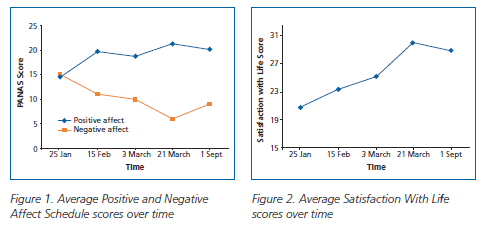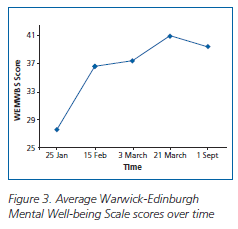The three-part ABC television series Making Australia Happy was screened in November 2010. The series took the science of positive psychology to the streets in Marrickville, a suburb in inner-city Sydney, and followed eight individuals as they completed an intensive eight week positive psychology program using scientifically-validated positive psychology interventions. I was fortunate enough to be asked to be the coaching psychologist of the show and in this article I reflect on my experiences, and present results from a follow-up study indicating that the positive effects of participation were still evident 24 weeks after filming finished.
There is considerable public interest in positive psychology. The show generated the largest ever web-based response to an ABC program, with over 200,000 hits on the ABC website immediately after the first episode (crashing the ABC servers), and over 40,000 registered individuals taking online assessments and doing positive psychology exercises. There were more than one million website hits in the following month. The overarching aim of the series was to introduce positive psychology concepts to the general Australian public in order to encourage the use of scientifically-validated approaches to the enhancement of wellbeing on an individual and community level. To do this we needed a broad representation of contemporary inner-city Australia.
The selection process: Duty of care considerations
The selection process was challenging. We used information flyers, local papers, radio and the internet to stimulate interest in the series. Duty of care considerations were primary. The program was not designed to treat mental illness, and appearing on television is itself stressful, so potential participants were carefully screened by an independent clinical psychologist to ensure those selected did not have major mental health or psychiatric problems. As the psychologist presenter, I was particularly concerned to ensure that participation in the show would not adversely affect participants in any way. Finally, following extensive background checks, in-depth interviews with family members and comprehensive mental health assessments, we selected eight individuals.
The participants
We needed people that the general public could identity with (for full participant details refer to the series book, Eight Steps to Happiness (Grant & Leigh, 2010). We chose: Ben (in-debt, single male, 26); Liz O (34, recently separated mother with two young children); Liz K, (63, recently retired academic in a long-term relationship); Tony (42, married with two young children and stressed with the pressures of running his own real estate business); Steven (51, former architect, married with four children and working long hours); Rebekah (40, harassed mother of twin boys under three); Cade (34, highly artistic but lacking the confidence to take his art to the world, and living with Mathew his de-facto partner of eight years); and Natalia (34, single, unfit, overworked, trapped by negative self-talk, wanting to meet someone and start a family). In short, we selected eight very ‘normal' people trying to deal with the all-too-familiar stresses and strains of contemporary Australian life.
Measuring change: Psychological and physiological measures
The show format required a single, easy-to-understand ‘Happiness Score' that would allow participants and viewers to track progress over time. I was not entirely comfortable with the idea of reducing a complex construct such as happiness to a single score. After much discussion with the producers, and with peer consultation, we developed a composite measure - the ‘Happy 100 Index'. This used a number of well-validated measures, including the Positive and Negative Affect Schedule (Watson et al., 1988), the Warwick-Edinburgh Mental Well-being Scale (Tennant et al., 2007) and the Satisfaction With Life Scale (Diener et al., 1985), and other measures of depression, anxiety and stress. The Happy 100 Index was designed so that a score of 50 represented a neutral affect level, with scores greater than 50 indicating more positive than negative affect and scores less than 50 indicating more negative than positive affect.
But we wanted to go beyond self-report measures, so we also used a range of physiological measures including blood pressure, stress-related cortisol, sleep-related melatonin and the immunity marker Immunoglobulin A. We also assessed the impact of participation on brain activity using Magnetoencephalography (MEG) brain imagining.
What happened?
For eight weeks the participants undertook a range of scientifically-validated positive psychology interventions. These included mindfulness exercises, gratitude and forgiveness interventions, the performing of altruistic acts, indentifying personal goals and values, and strengths-related assessments and coaching to help them reach their goals.
The program took a holistic approach. In addition to completing positive psychology interventions, participants had their physical exercise levels, sleep patterns and diet examined. All participants wore lightweight armbands that recorded physical movement. They were given detailed feedback on these measures, and exercise and dietary changes were implemented where needed.
The results were fascinating. As a psychologist I had anticipated some self-reported changes in psychological state. As expected, over the eight weeks participants' self-reported levels of depression, anxiety and stress reduced remarkably, and levels of subjective wellbeing and psychological wellbeing increased. In short, negative affect decreased and positive affect increased (see Figures 1 to 3).
I had not expected the substantial improvements in biological markers of wellbeing. At the start of filming, half the group had high cholesterol, five of the eight had low melatonin, and six had unhealthily high levels of cortisol. At the end of filming those with unhealthy blood pressure and cholesterol levels showed a substantial drop, compared to what would be expected if they had taken medication. Their cortisol levels became normal and there was an average 60 per cent increase in melatonin levels. In addition, their levels of the immunity marker Immunoglobulin A increased by 36 per cent following a day of altruistic charity work. Their increases in psychological functioning were manifest in other physical markers of resilience. At the start of the filming we put the participants through the cold presser test - asking them to hold their arms in ice cold water for as long they could stand it. At the beginning of the program the average time was 57 seconds, increasing to 131 seconds post-program.
Interestingly, pre-post MEG brain scans showed significant positive changes in brain functioning; there was a substantial pre-post reduction in neural activity in the parietal and temporal lobes during tests in which participants were shown stimuli consisting of faces expressing happy, sad and neutral emotions. Associate Professor Mark Williams from the Macquarie University Centre for Cognitive Science commented that these findings were similar to studies demonstrating a similar decrease in the brain activity of experienced meditators compared with novices. Of course, it must be emphasised that this was not a controlled psychological experiment, and sample size was small, with many potentially confounding variables. But nevertheless these results were impressive.


Follow-up findings: 24 weeks
Over the course of the program, the group average Happy 100 Index went from 48 in week one to 84 in week eight - a remarkable improvement. But I wanted to know if these positive psychological changes would maintain over time, once the cameras and crew left. A follow-up psychological assessment 24 weeks after filming finished indicated that the psychological gains were maintained. The group average score on the Happy 100 Index remained high at 80, indicating that the program was indeed effective, and not just during the period of filming.
Which was the most effective intervention?
One key learning that has great relevance for practitioners ‘on the ground', was that there is no single most effective positive psychology intervention. Applied positive psychology is not a one-size-fits-all approach. Although all participants took part in certain group activities and all participants wrote a personal eulogy designed to highlight personal goal and values, overall we encouraged participates to undertake interventions best suited to them and their life situation.
It also became clear to the participants that physiological issues such as lack of sleep, and poor diet and exercise played a significant role in their wellbeing. Positive psychology has not placed great emphasis on the role of physiology, but it is hard to feel energised or happy on minimal sleep or a diet of cola and pizza! These were important reminders about working holistically with clients - cognitive or emotional change is not enough.
Final reflections and comments
My participation required me to take on multiple roles: coach, counsellor, television presenter and consultant. One minute I was presenting, then next acting as coach or counsellor, the next giving consultancy advice! I found holding so many conflicting boundaries and role expectations extremely challenging. Fortunately, I had access to good external supervision which was essential in helping me manage the unexpected role stress.
Importantly, we did not just focus on the so-called ‘positive emotions'. Our underpinning philosophy was that positive psychology is not just about pleasant emotions or experiences. We encouraged participants to embrace the full range of human experiences - not to shy away from sadness, but rather to build a full, meaningful and engaged way of living. And that approach seemed to resonate both with the participants and the viewers.
Well balanced, evidence-based television shows on positive psychology and wellbeing have terrific potential to make psychology more accessible and relevant to the general public. An important medium for a very important message. Let's use it.
Acknowledgments
I would like to gratefully acknowledge the invaluable work of Dr Russ Harris and Anna-Louise Bouvier, my television co-presenters, and the professionalism of the whole production team, in particular Jennifer Cummins, Daryl Karp, Kalita Corrigan, Will Parry and Danielle Brigham.
The author can be contacted at [email protected].